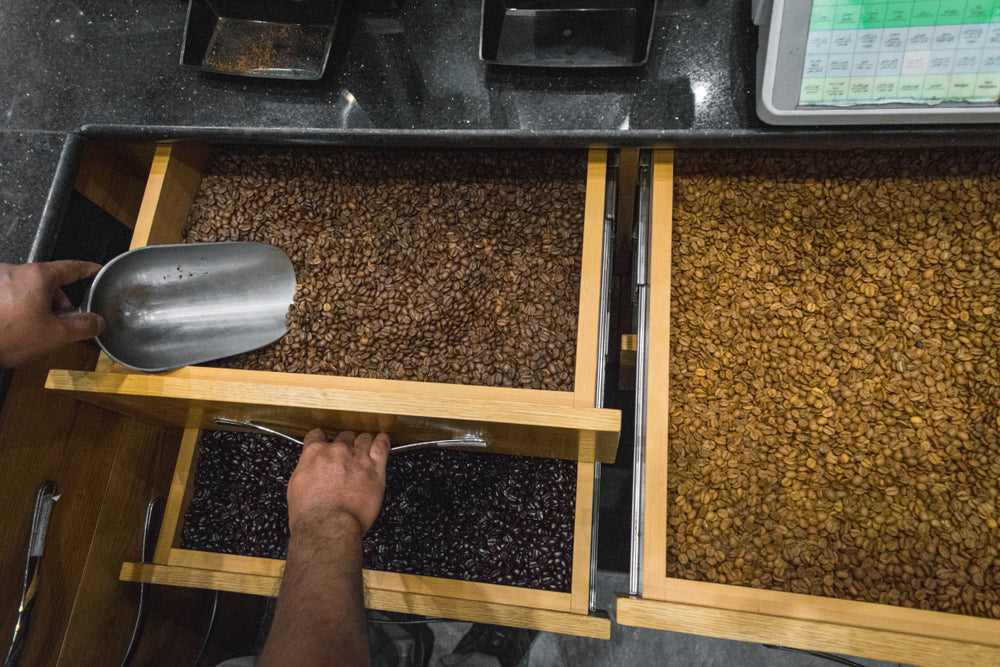Your Cart is Empty
Menu


Single Origin Coffees Versus Coffee Blends
September 29, 2023 4 min read
Single Origin Coffees Versus Coffee Blends
Single Origin Coffees Versus Coffee Blends: A Guide for Coffee Lovers
Customers often ask me the difference between single origin coffees and coffee blends. Here's a quick overview:
Single origin coffee is coffee that comes from a single farm or region. This means that the coffee beans in the bag all come from the same place, which gives the coffee a unique flavor profile. Single origin coffees are often more complex and nuanced than blends, and they can offer a wide range of flavor possibilities, depending on the growing conditions and processing methods used.
Coffee blends are made up of coffee beans from different farms or regions. This is done to create a more balanced and consistent flavor profile. Coffee blends are often used in commercial coffee shops and cafes, as they can be more forgiving to brew and produce a more predictable cup of coffee.
Here are some of the key differences between single origin coffees and coffee blends:
Flavor profile: Single origin coffees often have more complex and nuanced flavor profiles than blends. This is because the coffee beans are grown in different conditions and processed in different ways. Coffee blends, on the other hand, are designed to have a more balanced and consistent flavor profile.
Traceability: Single origin coffees are often more traceable than blends. This means that consumers can learn more about where their coffee came from and how it was produced. This information is important to many coffee drinkers who are concerned about sustainability and ethical sourcing practices.
Price: Single origin coffees are often more expensive than blends. This is because they are more difficult to produce and source. Single estate coffees, which come from a single farm, are even more expensive.
Which type of coffee is right for you?
If you are looking for a coffee with a unique and complex flavor profile, then a single origin coffee is the way to go. If you are looking for a coffee that is more balanced and consistent, then a coffee blend may be a better option.
If you are new to coffee, I recommend starting with a coffee blend. This will give you a good introduction to the different flavors that coffee can offer. Once you have developed a better understanding of coffee flavor, you can start exploring single origin coffees.
No matter what type of coffee you choose, I encourage you to experiment and find what you like best. There is a whole world of coffee out there, and there is something for everyone to enjoy.
For example, our single-origin Ethiopian Natural boasts a deep, mocha bouquet with intense blueberry and marmalade fruit notes through to a clear, refined finish. Our single-origin Rwanda Microlot, however, is smooth, slightly tart, with bright citric flavor notes and subtle grapefruit in the finish.
Both are from Africa, yet both have different flavor profiles. Single-origin coffees are more specific and personal tastes can be tantalized and thoroughly explored with tempting the palate with different single-origin coffees from different coffee farms.
Coffee Blends
Coffee Blendscould not exist without single origin coffee. A coffee blend is made up of single origin coffees that have been blended together to create a highly unique and complex flavor profile. Because a coffee blend is comprised of more than one type of coffee beans, the flavor notes are a lot harder to pick out. In the coffee world, we describe coffee blends as “full-bodied” because they are more intricate to the palette. Like single origins, coffee blends can offer very different flavors to appease different personal preferences.
When it comes to coffee blends. for John Weaver, blending coffee is an art in itself. The exact green coffee bean combination of each of our coffee blends is decided by first roasting the coffee beans to a specific origin, which is then mixed with varying amounts of other roasted coffee. Methodically, we narrow it down to the perfect cup of coffee. We do this through cupping—a skill mastered through time and experience. Having cupped roughly two hundred coffees a day, John Weaver and his team of apprentice roasters, have the ability to commit these tastes and flavor profiles to memory. They are also very busy after tasting so many coffees each day.
What Type of Coffee is Served in a Coffee Shop?
In our coffee shops, one of the questions we get asked the most often is what kind of coffee beans are we using for our espresso?
Espresso is a richly flavored, highly concentrated form of coffee that is brewed by forcing small amounts of pressurized, nearly boiling water through finely-ground coffee beans. Due to its method of preparation, espresso is generally thicker than coffee and it is served in shots with each shot measuring about an ounce.
We use our Weaver’s Espresso Blend coffee, which is full-bodied with remarkable depth, flavor overtones of fine wine, citrus and berry, ending with a super-sweet finish. While every coffee shop is different, we stick with using a coffee blend for our espresso shots and espresso drinks. Because espresso is so concentrated, using a single-origin coffee might be a little too intense for some. Often single-origin coffee pulled as espresso is described as “fruity” and “floral”. Since the single-origin coffee beans typically only come from one area or one farm, the single-origin espresso shot will have less depth and character, so we stick to John’s combination of perfectly roasted and blended beans to bring forth our espresso.
Which Type of Coffee is Best for You?
Both single-origin coffee and coffee blends offer highly unique flavor profiles to consumers. There is no right or wrong answer about what coffee is best for you, as it really depends on what you prefer in a cup! Take the time to explore various coffees and see which flavor profile tickles your palate.